13 Popular Types of Pond Turtles (With Pictures)
Pond turtles are one of the most common turtles found in North America.
This isn't surprising as most of them make up the family of turtles called Emydidae, which is the largest and most diverse turtle family on the planet.
And while there are around 95 different species in the Emydidae family, there are a few common turtle species that you'll either find in your pond or add to your pond as pets.
So, let's look at the 13 most popular types of pond turtles along with their descriptions, facts, and pictures for easy identification.
Types of Pond Turtles
As mentioned above, the majority of pond turtles are in the Emydidae (pronounced Emy-di-dee) family. However, you'll find a few other species of semi-aquatic turtles in ponds from other families, like the snapping turtle, mud turtle, and musk turtle, which we'll also cover below.
Painted Turtles
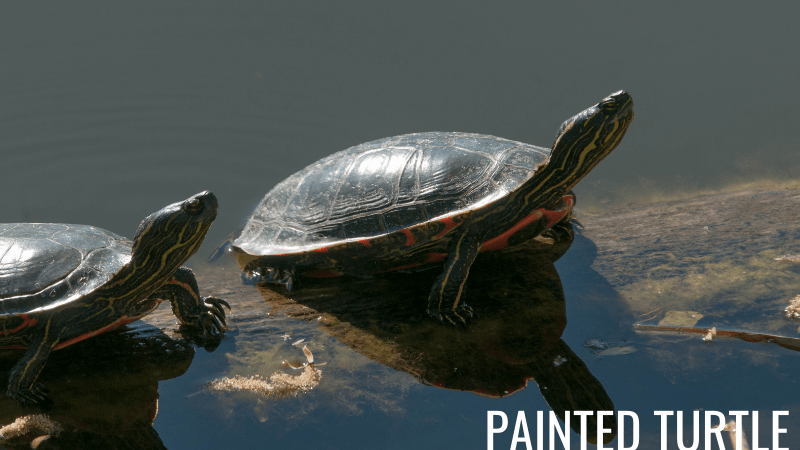
Species: Chrysemys Picta
Size: 4 to 10 inches long
Lifespan: More than 55 years
As one of the most common turtles of North America, the painted turtle covers a geographical range between Northern Mexico all the way up to Southern Canada. The top of their shells are smooth and dark, lacking the ridge typically seen on some other types of freshwater turtles. Skin ranging from olive to dark is beautifully decorated with a combination of orange, red, or yellow stripes along its legs.
Painted turtles enjoy slow-moving freshwater and consume a diet of algae and aquatic vegetation, as well as small insects, fish, and crustaceans. You can also feed them turtle pellets and feeder fish if you keep them as pets in your pond.
Several subspecies are easily distinguishable, according to markings found on their shells. Eastern painted turtles feature top shell segments that are aligned in a straight manner. The top shell of the southern painted turtle is adorned with a red stripe. A western painted turtle displays a red pattern along the bottom of its shell. And the midland painted turtle typically has a large gray mark on the bottom side of its shell.
An innate ability to inhabit human-disturbed settings has kept the painted turtle among the most abundant of North America. Although they continuously face significant population reduction, through incidents such as roadkill, this type of turtle continues to thrive. Pond turtles, such as painted turtles, are most active during the day, spending time basking on rocks and logs for several hours to obtain warmth. Painted turtles hibernate during the winter months, typically within the mud at the bottom of any given body of freshwater.
Slider Turtles
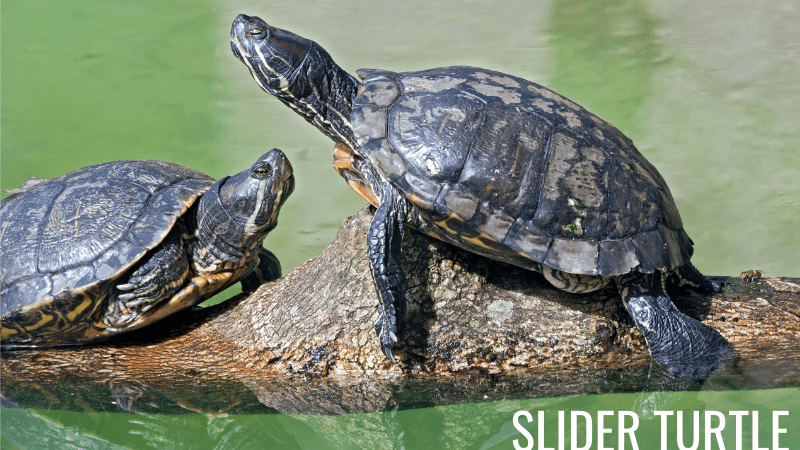
Species: Trachemys Scripta
Size: Varies by subspecies
Lifespan: 20 to 30 years
Two of the most common slider turtles found in ponds include the yellow-bellied slider and red-eared slider (commonly referred to as the red-eared terrapin). Either species of slider turtle is well adapted to warm or cool temperatures, especially with a good blend of food, land, and water. Their ability to consume anything ranging from algae to fruit and insects makes them quite popular among hobbyists.
Although the slider is considered the most invasive turtle, they are kept as family-friendly pets worldwide, especially in North America. They are named after a vibrant splash of color found on both sides of its head, located directly behind either eye.
As a North American native turtle, the red-eared slider is found anywhere between Northern Mexico and the Southern United States. However, due to the release of pets into the wild, this type of slider has become well established in other regions. They are well-equipped to outcompete native turtle species, which is why they have earned the title on the world's list of 100 most invasive species, according to the IUCN.
Common Map Turtles
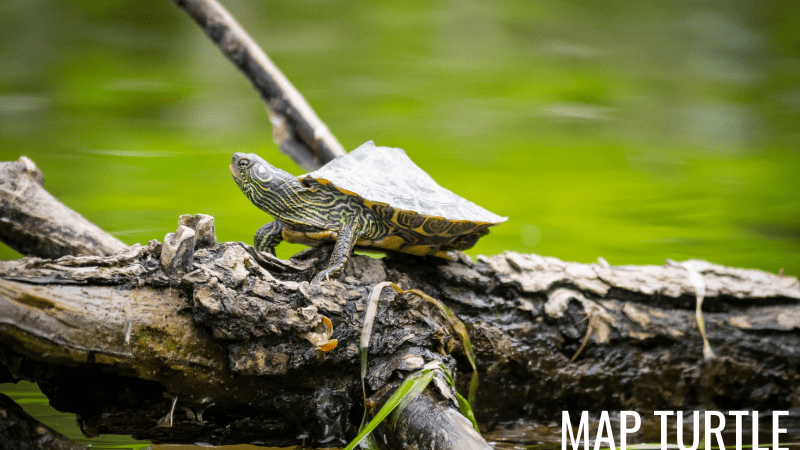
Species: Graptemys Geographica
Size: 4 to 10.5 inches long
Lifespan: 15 to 100 years
The map turtle is quite a diverse species of pond turtle, with markings across the surface of their shell commonly resembling a map. Their appearance can differ greatly, however, which is no surprise considering the many variations in genera.
Although map turtles are native to the United States, they are sold on a global scale. They are less of a nuisance than other types of freshwater turtles simply because they require high-quality water to survive and thrive.
With a temperature preference ranging from only 72-80° Fahrenheit (22 to 27 C), it is no surprise they are sensitive to other aspects of their environment. If their high standards are not appropriately met, they're prone to developing diseases such as shell rot and other bacterial infections.
Additionally, they prefer slow-moving water as opposed to still. In the wild, map turtles are generally discovered in rivers and streams, which are quite slow. For this reason, potential map turtle keepers should equip their pond with a fountain, waterfall, or pump to keep the water moving.
Another requirement of keeping young map turtles is their need to consume a diet predominantly comprised of plant matter. Duckweed, frog-bit, water lettuce, and water hyacinth are all considered essential food sources for the map turtle. However, it's important to note these floating plants are often considered invasive. So, be sure you are compliant with local guidelines before introducing these plants to your pond.
Otherwise, adults enjoy a mix of worms, crayfish, insects, and the occasional treat of kale, lettuce, and the like.
Box Turtles
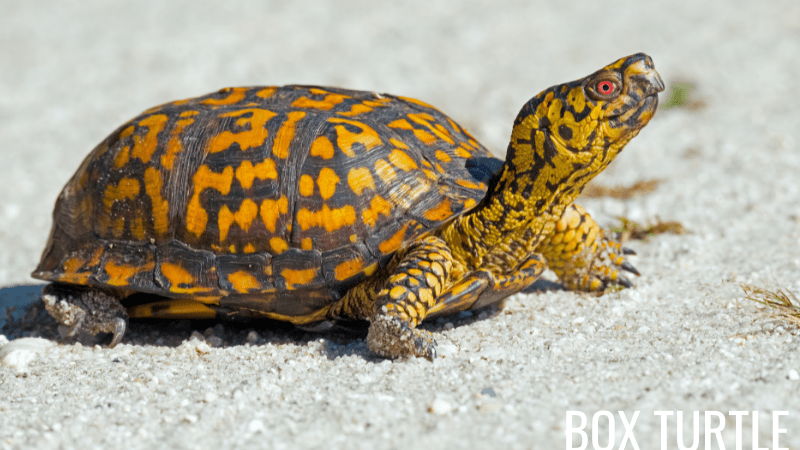
Species: From the Terrapene genus with several different species names
Size: 5 to 7 inches long
Lifespan: 25 to 35 years
Box turtles are native to North America, whereas eastern box turtles are native to the eastern portion of the United States. They are easily identified by their large, boxy shell, which can enclose itself completely due to a distinctive hinged lower shell. Additionally, the upper jaw of the box turtle is curved and long when compared to other turtles.
Box turtles enjoy a well-rounded diet of slugs, snails, insects, and berries.
This type of pond turtle is currently struggling to maintain its population, with a rather low reproduction rate. It is for this reason why it's never recommended to take a box turtle from the wild.
Because it is illegal to capture wild box turtles, individuals looking to keep box turtles as a pet should search for legally obtained captive-bred box turtles from an ethical breeder or pet store.
While they may be considered a popular pet, they can be difficult to maintain in captivity. This is because the box turtle gets stressed easily, requires high levels of humidity, is particular to certain types of substrate, and doesn't like to be held.
Their temperature requirements are also very specific, as they are naturally found in warmer areas of the US.
Bog Turtles
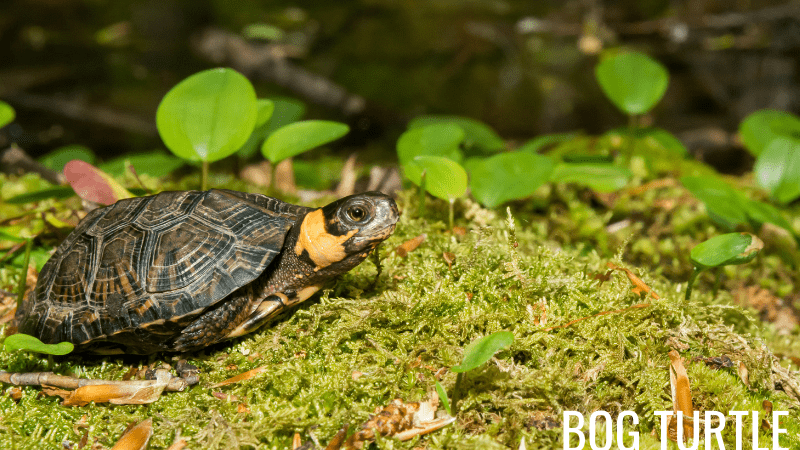
Species: Glyptemys Muhlenbergii
Size: 4 inches long
Lifespan: 20 to 30years
With a similar appearance to painted and spotted turtles, the bog turtle is actually the smallest in North America. When fully grown, the bog turtle has a shell measuring 4” (10 cm) in length, weighing in at an average of 4 ounces. Typically, their skin and shell are dark brown in color, and they have a single orange spot on both sides of their neck.
This omnivorous turtle feeds predominantly on small invertebrates and bugs.
Commonly found anywhere between Vermont, Georgia, and Ohio, the bog turtle, is secretive and diurnal. They enjoy spending their time burrowing in the mud and hibernating during the winter months.
Urban development and invasive plants have threatened the existence of the bog turtle due to the eradication of their natural habitat. They are considered so threatened, in fact, that they are protected at a federal level under the Endangered Species Act of the United States.
Ironically, the black market pet trade demand for the bog turtle remains at an all-time high. This is mostly due to their small size and characteristics – though private projects are underway to reverse the overall decline.
Western Pond Turtles
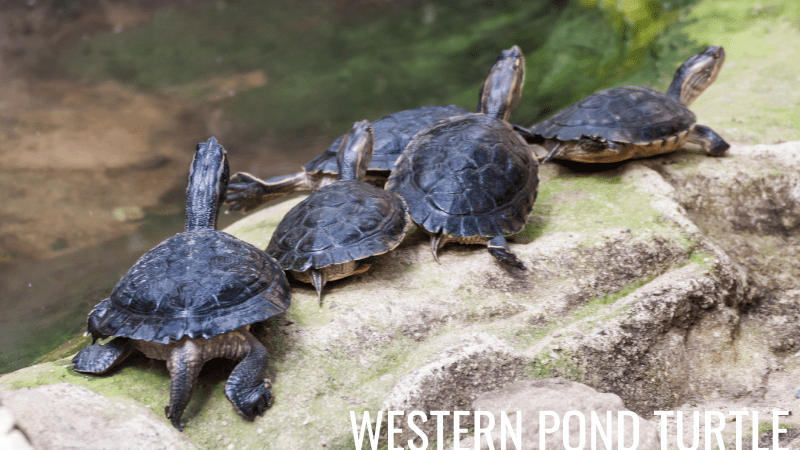
Species: Actinemys Marmorata
Size: 4.5 to 8.5 inches long
Lifespan: 50 to 70 years
As a common resident of rivers, small lakes, creeks, and ponds, western pond turtles are known to bask on boulders and branches of a floodplain. The Western pond turtle (aka Pacific pond turtle) will also frequent irrigation ditches, reservoirs, and marshes.
Overall, they are considered a pond turtle of medium size, featuring dark blotches and black spots on their head and a yellow belly. Shell shapes vary between genders, with males displaying a flatter shell and thicker tail. Females, on the other hand, exhibit smaller heads, flatter bellies, and higher dome-shaped shells.
The diet of a western pond turtle is mostly comprised of anything they can easily overpower and catch. They forage exclusively in the water and must consume their catch underwater.
Cooter Turtles
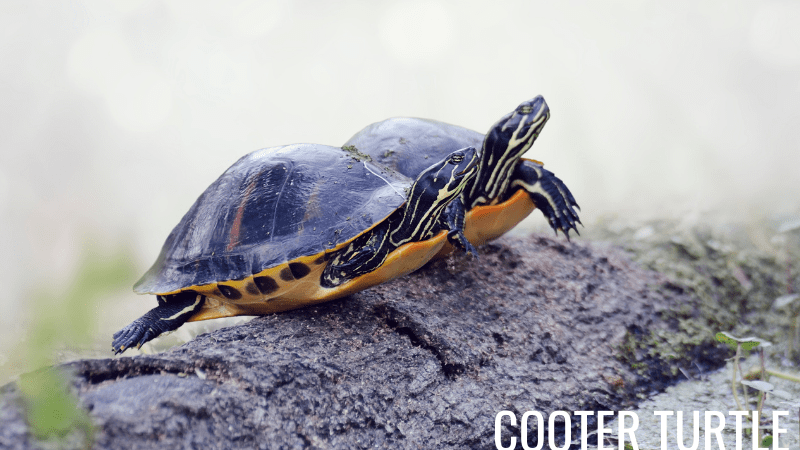
Species: Pseudemys
Size: Up to 16 inches long, but varies by subspecies
Lifespan: 40+ years depending on subspecies
Cooter turtles are part of the genus Pseudemys, which is comprised of seven species. The members of this diverse genus are considered to be the largest of the Emydidae family, which includes:
- Alabama red-bellied cooter
- Coastal plain cooter (also known as Florida cooter)
- Florida red-bellied cooter
- Northern red-bellied cooter
- Peninsula cooter
- Rio Grande cooter
- River cooter
This pond turtle can grow to lengths of 16” (40.64 cm) or more, weighing in at a maximum of 35 pounds (15.876 kg).
Every subspecies is aquatic, enjoying time in rivers, lakes, and ponds, where they may be spotted basking on logs or rocks along the floodplain.
Spotted Turtles
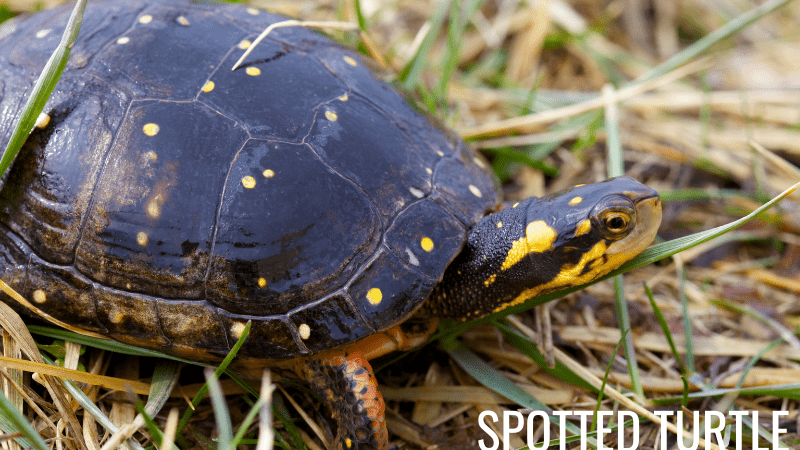
Species: Clemmys Guttata
Size: 3.1 to 4.7 inches long
Lifespan: 25 to 50 years
As a small, semi-aquatic turtle, the spotted turtle displays a smooth, broad upper shell of dark coloration. The carapace may also be adorned with a collection of yellow spots, which extends onto the head, neck, and limbs.
As inhabitants of various semi-aquatic areas, spotted turtles frequent marshes, bogs, woodland streams, ponds, and wetlands across the eastern United States and southern Canada.
This type of pond turtle is an active hunter, hunting for prey throughout the water by exploring aquatic plants with its head. Favored feeding months are anywhere between March and September, with temperatures ranging from 58°F (14C) and above. They are omnivorous turtles, feeding exclusively in the water. Spotted turtles enjoy a varied diet of berries, algae, aquatic vegetation, slugs, salamanders, spiders, insect larvae, worms, crustaceans, and more. They are also known to enjoy small fish (dead or alive).
Wood Turtles
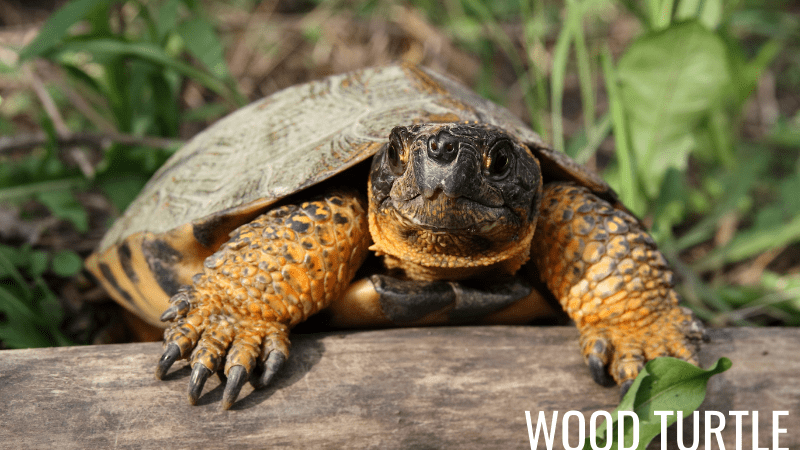
Species: Glyptemys Insculpta
Size: 5.5 to 7.9 inches long
Lifespan: Up to 50 years
Wood turtles are found in North America, with a size similar to spotted turtles and bog turtles.
The wood turtle can be found in a broad geographic range spanning from Minnesota to Nova Scotia and as far south as Virginia.
This type of pond turtle features a unique characteristic on the upper shell of pyramidal-shaped scutes.
Although it spends the winter in hibernation, like other pond turtles, they enjoy estivation during the hottest summer months.
The ideal aquatic environment for a wood turtle is bodies of moving water, especially in clear streams and wide rivers. Stagnated water is typically avoided, as it can lead to health problems and bacterial infections that pose dangers to the wood turtles' overall health.
European Pond Turtles
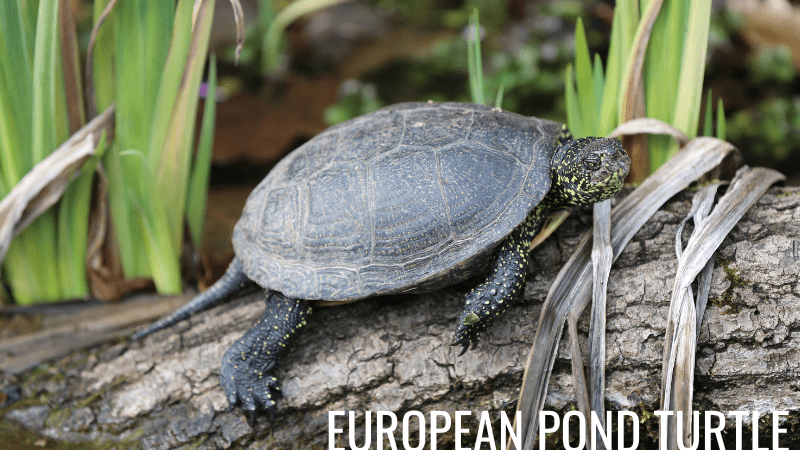
Species: Emys Orbicularis
Size: 4.7 to 15 inches, but varies by subspecies
Lifespan: 40 to 60 years on average
Found in many corners of the globe, European pond terrapins have been found in Europe, Northwestern Africa, Central Asia, and Western Asia.
This pond terrapin is dappled with yellow spots across the legs and head with a dark brown to black shell.
Size variations differ greatly within the same species due to temperature differences in distant regions. This is because temperature and thermal conditions play a vital role in this turtle's overall growth and development.
Its non-native status in the United Kingdom is because of its extinct status due to changes in the climate. However, because of the European pond terrapin's popularity among hobbyists, it has returned to the region by owners releasing these pets into the wild.
Depending on your location, it may be illegal to buy or own a European pond terrapin, a reminder that serves to highlight further the importance of checking local laws beforehand.
Get Our Best Pond Tips Sent to Your Inbox for Free!
Join thousands of others and learn from our decades of pond building and maintenance experience! Your pond will thank you!
By subscribing you agree to receive emails from PondAcademy.com. We will always respect your privacy and you can unsubscribe at any time.
Other Pond Turtles
Turtles commonly found in ponds from other families include:
Snapping Turtles
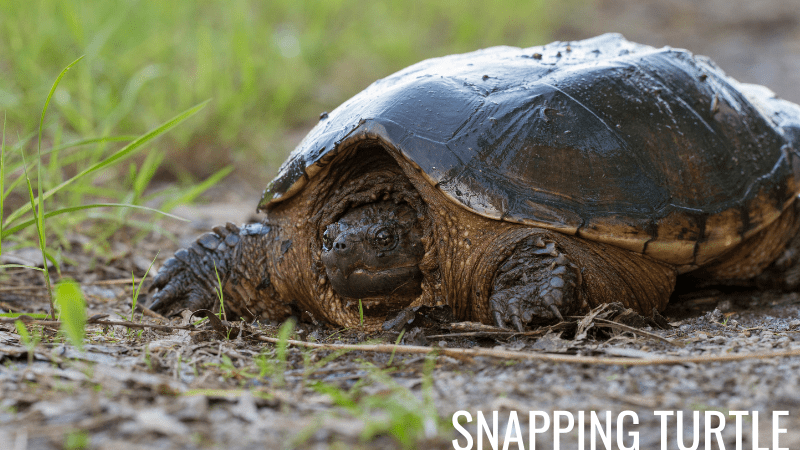
One of the large freshwater turtle families, Chelydridae, includes the common snapping turtle (Chelydra serpentina).
Its distinctive combative nature out of water sets it apart from other turtles, especially when its powerful beak-like jaws are considered. Their neck and head are also highly mobile, providing them with the means to strike a powerful blow.
However, they are quite different in the water, where they're known to flee and hide within sediment and substrate.
Plant and animal matter make up most of a snapping turtle's diet, with fish, frogs, reptiles, birds, mammals, and invertebrates making up the rest. Snapping turtles are active hunters, preying on anything alive that may be swallowed. Essentially, small prey may easily be caught without warning by a snapping turtle, as long as it will fit in their mouth.
These creatures also possess an unprecedented lifespan, with data suggesting their max-age is well over 100 years!
If you find a snapping turtle in your pond and have fish or children playing in or around it, it may be best to remove and relocate the turtle. Check out our quick guide on how to get rid of turtles in a pond for more information.
Mud Turtles
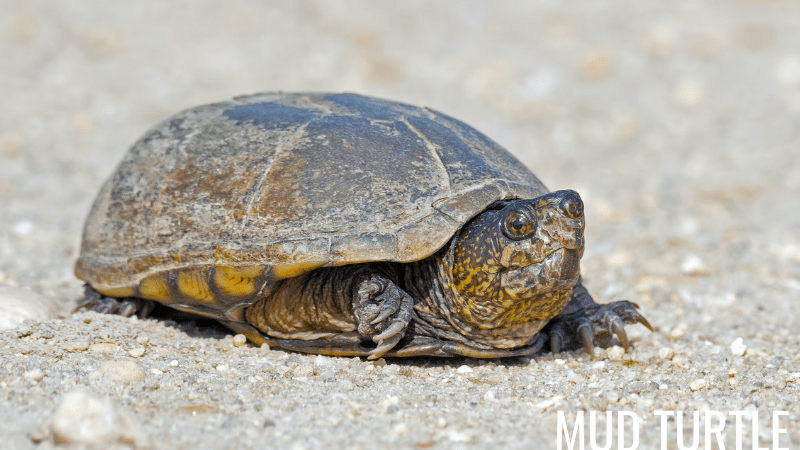
A species consisting of 18 types of semiterrestrial freshwater turtles of the Kinosternidae family, mud turtles are located throughout North and South America, including northern Argentina.
Much like musk turtles, the mud turtle is quite small, measuring up to 6” (15 cm) or less in length. However, unlike musk turtles, their lower shell features a hinge at either end. This enables the mud turtle to protect their head, tail, and legs whenever they feel threatened.
This omnivorous turtle has a taste for animal flesh, enjoying a varied diet of fish, fish eggs, worms, and arthropods.
Mud turtles are considered poor swimmers who prefer to walk along the bottom of bodies of water instead.
Musk Turtles
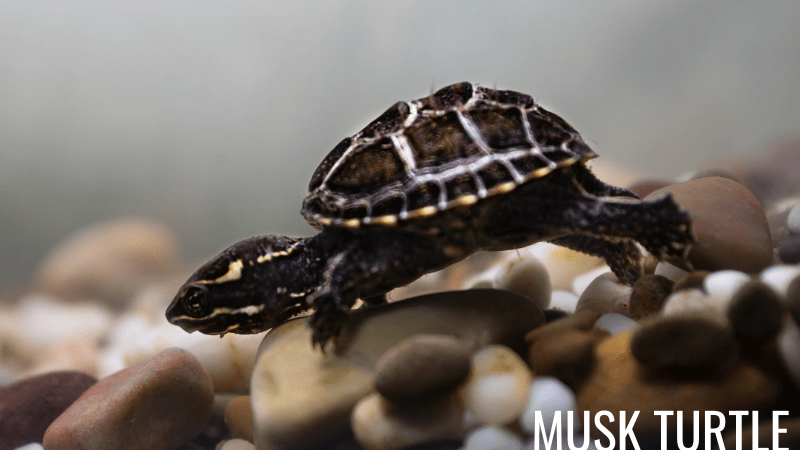
Commonly referred to as stinkpot, and rightfully so, the musk turtle has an innate ability to release a foul odor as a means of discouraging predators. Scent glands are located along the edge of their highly domed shell, capable of emitting a musky scent.
This small turtle species is part of the Kinosternidae family, native to a large portion of the Eastern United States and Southeastern Canada. They're typically grey, brown, or black in coloration, with a long neck and short legs. On average, their shell measures anywhere between 2 to 5 1/2” (5 to 14 cm) in length, with a max weight of 3/4lb (12 oz.).
While the musk turtle is predominantly carnivorous, they're considered more carnivorous as a hatchling. Once they're fully grown, an adult musk turtle will begin to enjoy the taste of aquatic plants, in addition to crayfish, aquatic larvae, insects, clams, and snails. They also enjoy feeding on tadpoles, fish, and carrion.
Throughout its life, the eastern musk turtle will be almost entirely aquatic. However, when the time comes to lay eggs, females will venture out of the water onto land. They will rarely spend their time basking on logs, opting instead to spend time in slow-moving waters.




